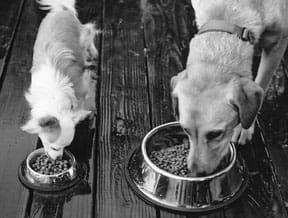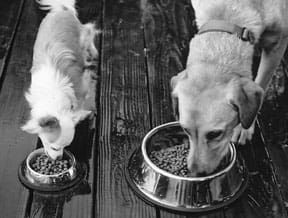[Updated August 18, 2017]
USING MEAL TIME FOR TRAINING OVERVIEW
- Take advantage of mealtimes to train and reinforce appropriate behavior and give your dog a good association with your presence at his bowl.
- Make sure all family members and visitors understand the importance of positive food bowl associations.
- Carefully manage conflict around food bowls to avoid fighting between dogs or aggression toward humans.
You may think of it simply as a convenient vessel, useful for keeping your dog’s food gathered in one place, off the floor. Your dog probably has a very different perspective. For him, the bowl is likely to be a high value object of great import, especially if he’s a hearty eater. In this magical dish, one or more times a day FOOD appears.
Mealtime carries great significance for most dogs. It can be fraught with excitement, arousal, and stress. A wise dog owner understands the importance of mealtime and uses it to her advantage.

Your dog’s feeding ritual can be used to reinforce good manners, practice deference exercises, and encourage a positive association with food, food bowls, feeding, and the presence of humans in the vicinity of his hallowed feeding vessel.
If you just dump food in his bowl and depositing it on the floor, you miss a golden training opportunity – and you might actually reinforce undesirable behaviors.
Meals are the Best for Training “Wait”
Mealtime is a perfect opportunity for twice daily “Wait” training sessions, using two principles of operant conditioning: positive reinforcement and negative punishment. Positive reinforcement (dog’s behavior makes a good thing happen) occurs each time you say “Yes!” and feed a tidbit. Negative punishment (dog’s behavior makes a good thing go away) happens every time he gets up and you put the bowl back on the counter or lift it out of his reach.
1. Have your dog sit at his designated dinner spot. Tell him “Wait!” If he remains seated, say “Yes!” and feed him one tidbit from his bowl (which you have placed on a counter).
2. With your dog still sitting, say “Wait!” and lift his bowl off the counter. If he remains seated, say “Yes!” and feed him a morsel (positive reinforcement). If he gets up, say “Oops!” and place the bowl back on the counter (negative punishment). Repeat until he stays seated when you pick up his bowl.
3. With your dog still sitting, say “Wait!” Lower the bowl halfway toward the floor, one to two feet in front of him. If he remains seated, say “Yes!” and feed him a tidbit from the bowl. Raise the bowl several inches and repeat a number of times until you’re sure he’ll remain seated. If he gets up say “Oops!” and raise the bowl above the level of his head. Try again, and don’t lower it quite so far this time.
4. With your dog still sitting, repeat the “Wait” exercise until you can lower the bowl all the way to the floor without him getting up. When he’ll hold his sit with the bowl on the floor, tell him “Okay!” or “Get it!” and encourage him to eat.
Practice your dog’s “Wait” training every time you feed him. You’ll teach him a useful good manners behavior, and remind him at every meal that you’re the benevolent leader, controlling the good stuff, but happily sharing with him as long as he offers a deference behavior (sit) and minds his manners.
Meals VS. Free Feeding
I cringe internally when a client tells me she free-feeds her dog – that is, keeps the bowl on the floor filled with kibble all the time. I’m a strong believer in feeding meals for a number of reasons, in addition to the medical fact that a dog’s digestive system is designed more to gorge than to graze. There are numerous advantages to feeding your dog specific amounts of food at specific times:
• You can monitor intake. If you feed meals, you’ll know the instant Buster goes off his feed – sometimes the first sign that he’s not feeling well. If you just keep the bowl topped off, it may be a day or two before you realize he’s not eating.
• You minimize your dog’s opportunities to guard his food. If there’s always food in the bowl, your dog might just decide he needs to protect his valuable resource and the territory around it. If the food bowl is picked up when it’s empty, the feeding zone becomes more neutral.
• You can utilize feeding time as training time. Teach him good manners and impulse control by reinforcing a “Sit/Wait” behavior while you place the bowl on the floor, then give him the cue to eat (see “Wait Training” sidebar).
• You can take advantage of feeding time to reinforce your role as the higher-ranking member of your social group. You can’t be the “alpha dog” – your dog knows you’re not a dog – but you are a member of his social group. The leader controls the “good stuff,” and dinner is definitely “good stuff.” If food is available all the time, your dog controls it. If you, as benevolent leader, choose to share some of your food with him out of the goodness of your heart, and he performs a deference behavior such as sit or down to get you to share, you’re reinforcing a healthy relationship.
• You know when he’s full, and when he’s empty. Your training sessions are more likely to be successful if you train when your dog’s stomach is empty rather than full.
• You can use his meals as training treats. This is particularly useful for building a relationship with a dog who’s not convinced he needs you. If all good things, including meals, come directly from your hand, he’s more likely to decide you’re important in his life.
• You can control your dog’s weight. Is he looking a tad too prosperous? Cut back a few calories from his portions. Looking a little ribby? Add an extra half-cup to his bowl.
• You may spark his appetite. People with fussy eaters often make the mistake of leaving food out constantly. The dog grazes all day and never gets hungry, thus never gets eager for food. Offering food, leaving it down for 10-15 minutes, then picking it up, can teach a picky eater to take advantage when he can, or wait for the next meal.
If you have multiple dogs, free-feeding can be even more problematic. One dog may eat more than his share and plump up, while another dog goes hungry. You’re even less likely to notice if one dog is off his feed, since the other is still eating and the food’s still disappearing. Tensions may escalate around the bowl, and fights can occur.
Of course, there are plenty of dogs who can share food resources amicably. Yours might share nicely, but you still miss out on all the other benefits of meals.
The Dog Feeding Ritual
There was a time when trainers recommended following routines that supported the status of the higher-ranking dog in the pack. Feed the “alpha dog” first, they said, and move on down the line. That thinking has changed.
Since I’m the highest-ranking member of the social group in my home, I get to make the rules, and I can decide if the rules change. Today, I might choose to feed a lower-ranking dog first, and move up the line. Or start in the middle, and move toward the ends. Or randomly select appropriate behaviors to reinforce with the food bowl. Of course, since we now know that pack hierarchy is more fluid than once thought, I might be guessing wrong about which dog has the highest rank on any given day, but that doesn’t matter. I’m still the leader, and I get to decide with whom I share food, and when.
In my canine group, Katie the crazy Kelpie often obsesses about Tucker moving toward his food bowl. She’ll stand behind him and bite his hocks if he moves. To help him out, I may invite Katie to eat first so Tucker can walk to his bowl without torment.
Lucy, the year-old impetuous Corgi, is convinced she should always eat first, and can barely contain herself if I feed someone else before her. So, of course, I do, so she can practice her self-control lessons. If she waits calmly on her mat, she may be next. If she’s dancing and whining for her breakfast, her bowl is slow to arrive.
Katie, 13 and arthritic, and Tucker, who has bad knees, are no longer required to sit and wait for their bowls, but Lucy and Dubhy, the five-year-old Scottie, are still reminded each meal that good manners and deference behaviors make food happen.
You get to decide what your particular mealtime rules are, but in general, chaos is not acceptable, and calm is good. Perhaps all dogs go to their respective place mats and wait for dinner to arrive. Maybe they just have to sit, lie down, or stand around quietly to make food happen. Whatever your desired doggie dinner behavior, you can reinforce acceptable behaviors by continuing with your meal preparations when dogs are calm. If dogs get too excited, take a seat and read a magazine until calm returns, then continue on.
When Dusty the intrepid Pomeranian was still with us, he was convinced that barking made food happen. This is a classic example of “superstitious behavior,” where a dog believes that because a particular behavior – such as barking – occurred prior to an event of significance, that behavior can positively influence future outcomes, even though the two aren’t really connected.
In Dusty’s case we had to convince him that barking made food preparation stop, and quiet made food happen. We weren’t entirely successful; ultimately we simply resorted to an outcome wherein barking made Dusty end up outside, and quiet brought him back in to eat.
When Dogs Fight Over Food
Food guarding is a natural, adaptive survival behavior for dogs. In the wild, if a dog doesn’t lay claim to his valuable resources and defend that claim, he will likely starve to death. Wild canids who successfully defend their claims live to pass their genes on to their puppies.
While guarding from humans is a dangerous and unacceptable behavior, dogs should be able to reasonably protect their food from their canine peers. “Reasonably” means appropriate use of body language signals – some posturing, a glare or two, maybe even a raised lip. It doesn’t mean launching, lunging, biting, fighting, and/or causing punctures and lacerations.
If your multi-dog household erupts into all-out war during meals, it’s time for a serious management plan. Depending on the intensity of the conflict, you can:
• Feed in opposite corners of the room and play referee – making sure one dog doesn’t approach or threaten another, and picking up bowls when dinner’s over to remove the high-value, guardable object.
• Feed in opposite corners of the room and put all dogs on tethers to ensure they don’t threaten each other.
• Feed in different rooms with closed doors or baby gates in between to prevent conflict.
• Feed in crates, far enough apart that guarding isn’t an issue.
You may also want to try to modify the behavior. This is best done with the guarder tethered, and a second person handling the other dog so the interaction is controlled, while working your way through the following series of modification exercises.
Warning Signs of Dog Distress Over Food
It’s important that you recognize subtle signs of food bowl-related stress in your dog, as these are the precursors to more obvious signs of aggression. The sooner you can recognize your dog’s discomfort, the earlier you can intervene, prevent aggression from happening, and be more successful at modifying the behavior. Here are some subtle signs to watch for:
■ As you approach your dog at his bowl he stops eating and freezes, with his muzzle still buried in his food.
■ As you approach he gives you a “whale eye” – with his nose still in his bowl, he rolls his eyes at you so you can see the whites around the edges.
■ As you approach he eats faster.
■ As you approach he blocks you with his body and keeps eating, or tries to push the food bowl away from you.
Growling, snapping, lunging, and actually biting are more obvious signs of food-guarding. Some dogs will leap to the obvious signs without giving you more subtle warnings. Punishing subtle warning signs will make him less comfortable, and may suppress those signs so he jumps right to lunging and biting. Remember that your goal is to make him comfortable with you approaching his food. You can best accomplish this through a systematic program that changes his association with your presence at his bowl from “Uh-oh, she might steal my food,” to “Yay! More chicken!”
Modifying Guarding Behavior:
Series #1
• Step 1: With you standing next to Guarder, have the other person walk Dog #2 into the far side of the room on a leash. The instant Guarder notices the other dog, start feeding Guarder scrumptious treats, such as tidbits of chicken. When the other dog leaves, the chicken stops. You may want to have your “other person” feed treats to Dog #2 as well, to keep her attention focused on her handler, away from Guarder.
• Step 2: Repeat Step 1 numerous times, until the presence of Dog #2 causes Guarder to look happily to you for bits of chicken.
• Step 3: Gradually bring Dog #2 closer, watching for any stress/warning signs from Guarder (see “Warning Signs of Stress” sidebar).
• Step 4: Work at each new distance until you get a consistent “Where’s my chicken?” response from Guarder, then decrease the distance another increment.
Series #2
When Dog #2 can come close – say, within five feet of the end of Guarder’s tether – without eliciting stress/aggression signals from Guarder, go back and repeat Steps 1 through 4 with Guarder’s empty food bowl on the floor next to him.
Series #3
When Dog #2 can come close with the empty food bowl on the floor, repeat Steps 1 through 4, but this time drop the bits of chicken into Guarder’s empty bowl instead of hand feeding them.
Series #4
When Dog #2 can come close with chicken bits dropping into the bowl, repeat Steps 1 through 4, but this time start with some of Guarder’s regular food in the bowl on the floor, adding bits of chicken as Dog #2 approaches.
If you’ve done your work well, by the time you reach the end of Series 4, Guarder should understand that when Dog #2 approaches, it makes good stuff happen. Continue to referee off-leash interactions at feeding time, watching for the recurrence of stress signals from Guarder that may indicate more practice sessions are needed.
As with all aggressive behaviors, if you feel the risk to your safety (or your other dog’s safety) is high, or your modification work doesn’t improve the behavior, we recommend seeking the assistance of a qualified trainer/behavior professional.
Guarding from Humans
Dogs who guard their food from humans are a significant threat. If the only thing the dog guards is his food bowl, manage the behavior by feeding him in a separate room, with the door closed, and inviting him out before you go in to pick up the empty bowl. If he generalizes his guarding to other high-value objects, the risk increases by leaps and bounds, especially if you can’t predict what he may decide is valuable to him.
If you have a puppy, start early by associating your presence near his bowl with good stuff; drop yummy tidbits into his bowl as he’s eating, so he doesn’t feel threatened by your presence. Don’t allow family members to tease or torment him at the food bowl, and if he does exhibit signs of guarding, don’t punish! Punishment will only convince him that you’re a threat to his food – you have to work harder to convince him you’re not (see “Eliminate Aggressive Dog Guarding Behaviors,” WDJ September 2001).
Jean Donaldson’s excellent book, Mine!, offers a step-by-step program for modifying food-bowl guarding, but again, we advise you to heed the warning: If you feel the risk to your safety is high, or your modification work doesn’t improve the behavior, we recommend seeking the assistance of a qualified trainer/behavior professional.
Pat Miller, CBCC-KA, CPDT-KA, is WDJ’s Training Editor. She is also author of The Power of Positive Dog Training, and Positive Perspectives: Love Your Dog, Train Your Dog. Miller lives in Hagerstown, Maryland, site of her Peaceable Paws training center.





